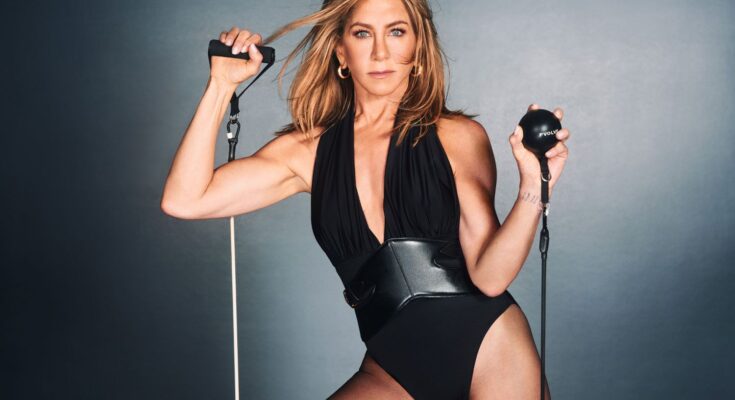Jennifer Aniston is heating up social media with a look at her recent workout.
The Friends alum put her toned bod on display in dark leggings and a pink fitness top that bared her sculpted midriff to promote Pvolve’s new portable Travel Bundle, allowing you to work out anytime, anywhere, “just like Jennifer Aniston.”
In the Instagram video, Aniston’s fans saw her doing a series of intense workouts to lengthen and tone, as she called the moves and the workout equipment, like ankle weights and glider discs, “small but deadly.”
She then showed off how quick, easy and convenient it was to put away the travel bundle, emphasizing “love your life, love your body.”
“You are my best inspiration EVER❤️ LOVE YOUUU,” one fan wrote, with another adding, “Awwwww you are so STUNNING AND FLAWLESS! Look this body omg 🫠🫠🫠.”
“jennifer aniston will always be THE goal ✨,” one comment exclaimed, as someone else complimented, “looking GREAT.”
:max_bytes(150000):strip_icc():focal(792x289:794x291)/Jennifer-Aniston-Shows-Toned-Figure-010124-tout-e0046d960e9047a4886b5b3b16b3d4ac.jpg)
Aniston informed Today that after years of pushing “too hard” at the gym, she’s embracing “listening to her body and focusing on low-impact training.”
She credits being the “most in shape” she’s ever been to her partnership with Pvolve, a full-body fitness method that promotes low-impact workouts with resistance equipment.
The Sculpt Anywhere Travel Bundle, which helps with staying active on the go, retails for $274.99 and is available starting today, April 10, per the press release.
Can You Do A Pull-Up? Here’s Why It’s A Must For Women
In the ever-evolving world of fitness, women are constantly breaking barriers and redefining strength. And today, many women seem to be more interested than ever in tackling one of the toughest feats in the gym: the pull-up.
Peep actor Brie Larson clearing the bar in her gym sessions while training for physical roles like Captain Marvel. (“Um, hi, don’t mind me achieving my one-arm pull-up goal!” she shared on Instagram.) Or, Jessica Biel last year repping out seated ring chin-ups with flawless form. On social media platforms like TikTok and Instagram, searches for #pullupsforwomen and #pullupsforbeginners have hundreds of thousands of results.
“It’s kind of in our heads that [the pull-up] is a hard thing. But it’s my superpower,” Tina Tang, CPT, strength coach and creator of the Women’s Health+ Ultimate Pull-Up Plan—launching April 14. And all of the steps you take leading up to your first pull-up—doing consistent, progressive strength training, working on grip strength, to name a few—”are health-positive,” she notes.
“A lot of our clients are setting [the pull-up] as a milestone goal,” says Heather Milton, CSCS, exercise physiologist at the NYU Langone Sports Performance Center, in this episode of the new WH vodcast series, Strong Science. “It’s a way to get empowered.”
If you’ve ever doubted whether working toward a pull-up was worth the effort, consider this your cue to commit. But don’t commit to just any training plan—you need a program made for women, by a female trainer, that speaks to your unique strength and musculoskeletal factors so you can conquer the iconic move quick and efficiently. That’s where the WH+ Ultimate Pull-Up Plan comes in—a six-week comprehensive strength training program that will get you to your first (or strongest) rep. (It’s available to WH+ subscribers starting Monday.)
Sign up for WH+ now to get the full Ultimate Pull-Up Plan, available to subscribers April 14. You’ll get access to Tang’s downloadable strength training program, eight exclusive videos, and tons of form and technique advice.
Tang says that training for the move isn’t just about building upper-body muscle. It’s about building all-over strength and understanding how to bust through the psychological hurdle surrounding the exercise, too. “Women often assume they can’t do a pull-up, but that’s because there is so much misinformation and discouragement around the exercise, and they’ve never trained for one properly,” Tang says. “The biggest shift I see isn’t just physical—it’s mental.”
Tune into the video ahead to watch WH executive health and fitness director Jacqueline Andriakos, CPT, discuss with Tang and Milton the surprising pull-up health benefit you haven’t heard about, how to conquer the mental piece, the biggest mistakes women make when attempting the exercise, and why this one move will change the way you think about—and train—your own strength.
How To Train Smarter
One of the biggest mistakes people make? Skipping the strength-training fundamentals and jumping right on to the bar, says Tang. “Most people jump straight to trying full reps without building the right foundation.”
Instead, Tang’s exclusive six-week strength training program breaks down pull-up training into three simple, achievable phases. With her progressive plan and expert guidance, you will do three dumbbell workouts per week that work every key muscle group and movement pattern necessary to do a full unassisted rep.
Each week, you will do a simple strength test to ensure you are ready to move on to the next phase. This way, when you move on to going for a full, unassisted rep, you will ensure that you have built up the level of strength and power you need to pull your chin above the pull-up bar.
The key? Progressing through Tang’s program at your *own* pace. “It’s not about going through the motions to get your first pull-up—it’s about gradually building the strength to get there by lifting heavy and challenging yourself in each workout,” Tang says. “If you stay consistent, the results will come.”
On the grip and longevity connection…
Milton: “We have some research that shows that grip strength is a good correlation to longevity—and especially in older adults it shows a lot of health benefits. The stronger your grip strength is when you’re older, the less likely you are to have [health] decline. But, really, it’s a representation of our overall muscular strength. And that’s something we’ve known for a long time: that if we maintain our muscles longer in life, we’re able to stay healthier longer, we have more stamina, we’re able to do more things—and that, then, just enables us to continue to be healthy.”
On how to fuel for strength training wins…
Milton: “Protein is typically something that a lot of women maybe don’t realize that they’re not getting enough. It’s important just to maintain your ability to recover… We do need enough calories to provide for what we call catabolism, which is building. So that’s part of it. And then the amount of protein that we’re getting is going to be important regardless of what the strength exercise is.”
Tang: “The pull-up is just like any other strength move, the way you would eat for it.”
Milton: “It depends on how much your exercising, but I would say try to stick to at least one gram [of protein] per kilogram of body weight for the general female population.”
On the biggest takeaway for conquering the pull-up…
Andriakos: “If someone walks away with one takeaway from this conversation to go and commit to their pull-up journey, what are you gonna tell them?”
Tang: “Two things: Lift weights and keep consistent.”
Milton: “You said it—commit. Being consistent with it and believing you can do it.”







